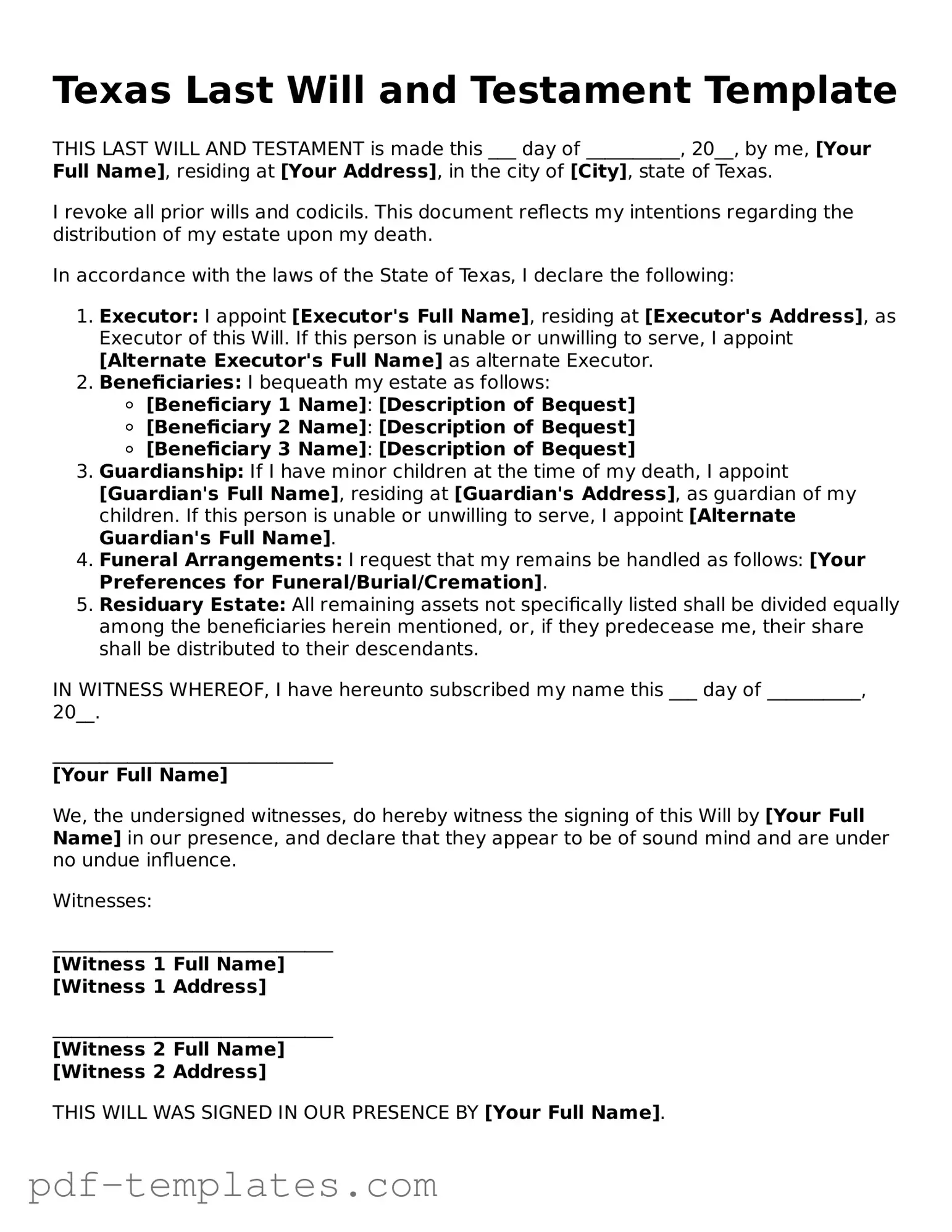The Texas Last Will and Testament form shares similarities with a Living Will. A Living Will is a legal document that outlines an individual’s preferences regarding medical treatment in situations where they may be unable to communicate their wishes. While a Last Will and Testament deals primarily with the distribution of assets after death, a Living Will focuses on healthcare decisions during a person's lifetime. Both documents serve to express the individual’s wishes, ensuring that their desires are respected, whether concerning property or medical care.
Another document that resembles the Texas Last Will and Testament is the Durable Power of Attorney. This legal document allows an individual to appoint someone else to make financial or legal decisions on their behalf if they become incapacitated. Like a Last Will, the Durable Power of Attorney is concerned with personal autonomy and the management of one’s affairs. However, it is active during the individual’s lifetime, whereas a Last Will takes effect only after death.
The Texas Declaration of Guardian is also similar to a Last Will and Testament. This document allows an individual to nominate a guardian for their minor children in the event of their death or incapacity. While a Last Will distributes assets, the Declaration of Guardian focuses on the care and upbringing of children. Both documents aim to provide peace of mind by ensuring that the individual’s wishes are followed regarding their dependents.
In addition, the Texas Revocable Living Trust bears resemblance to the Last Will and Testament. A Revocable Living Trust allows an individual to place their assets into a trust during their lifetime, with the ability to modify or revoke it as needed. Like a Last Will, it facilitates the transfer of assets upon death, but it can also help avoid probate, making the process faster and more private. Both documents serve the purpose of managing and distributing assets according to the individual’s wishes.
The Affidavit of Heirship is another document that relates to the Texas Last Will and Testament. This document is often used when someone dies without a will, allowing heirs to establish their rights to inherit property. While a Last Will clearly outlines who inherits what, the Affidavit of Heirship serves as a tool to determine heirs when no will exists. Both documents aim to clarify the distribution of assets, albeit in different circumstances.
A similar document is the Codicil, which acts as an amendment to an existing Last Will and Testament. A Codicil allows individuals to make changes to their will without creating an entirely new document. This can include adding or removing beneficiaries or altering asset distribution. Both documents maintain the testator’s intentions, but a Codicil is specifically designed to update or modify the original will.
The Texas Community Property Agreement can also be compared to a Last Will and Testament. This agreement allows spouses to manage their community property in a way that simplifies the distribution of assets upon death. Similar to a Last Will, it ensures that both partners' wishes are honored regarding asset distribution. However, the Community Property Agreement is specific to married couples and focuses on property acquired during the marriage.
The Bill of Sale is another document that shares some similarities with a Last Will and Testament, particularly in the context of transferring ownership. A Bill of Sale is used to document the sale or transfer of personal property from one party to another. While a Last Will outlines the distribution of assets after death, a Bill of Sale facilitates the transfer of ownership during a person's lifetime. Both documents ensure that property rights are respected and transferred according to the owner's wishes.
Lastly, the Prenuptial Agreement can be considered similar in purpose to a Last Will and Testament. A Prenuptial Agreement outlines how assets will be divided in the event of divorce or death. While a Last Will deals with the distribution of assets after death, a Prenuptial Agreement addresses asset management and division during marriage. Both documents aim to protect individual interests and clarify the handling of property.
